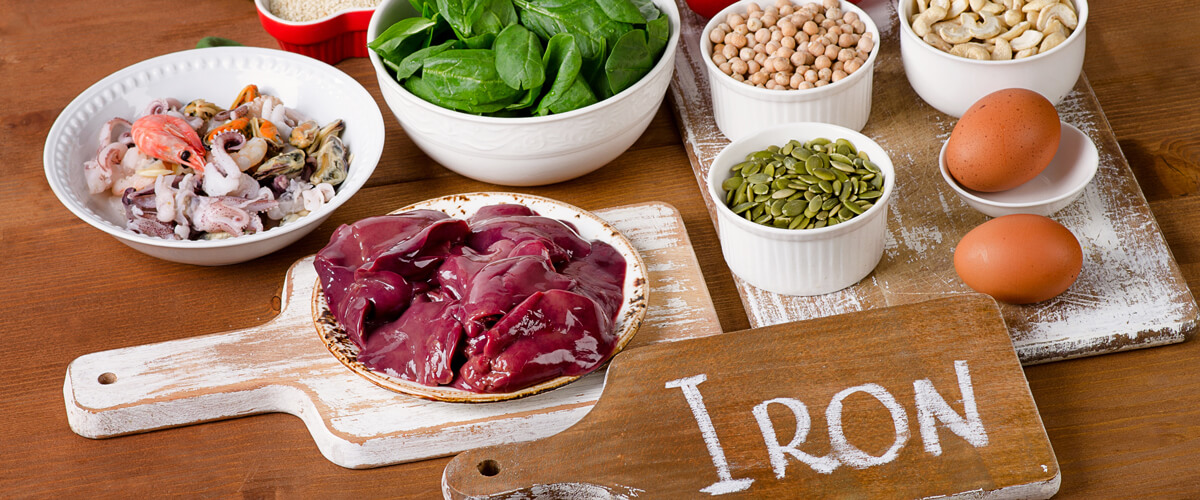13 Warning Signs - Iron Deficiency
Courtesy of NCSF
Despite iron being a key mineral in the formation of oxygen-binding molecules within the body, iron deficiency is the most common nutrient deficiency in the world. In fact, approximately 30-50% of the adult female population is believed to be iron deficient. Dietary iron comes in two natural forms; non-heme iron found in plant-based foods (2-10% absorption rate), and heme-iron found in animal products (10-30% absorption rate). Heme-iron is known to have the highest bioavailability, even when compared to iron supplements.
Due to iron’s role in the formation of hemoglobin, iron deficiency is associated with numerous issues caused by a reduction in the hemoglobin in circulation, which consequently impedes oxygen transport. The most common signs of iron deficiency include fatigue during exercise and a reduced appetite; key warning signs have been summarized in the following:
Exhaustion – Though many commonly “feel exhausted” as part of a busy day, it is the most common symptom and should be monitored; especially if combined with irritability or lack of concentration.
Pale skin tone – Easy to spot in individuals with a lighter complexion. Among individuals with a darker complexion look for a pale hue in the gums and behind the lips.
Trouble catching your breath – Considering hemoglobin is responsible for delivering oxygen to working tissues, a shortage will increase the demands placed on the respiratory system. This makes recovery from activities of daily living as well as structured exercise harder.
Restless leg syndrome – Research has shown that about 15% of people with restless leg syndrome are also iron deficient.
Chronic headaches – Swelling of the brain’s arteries in response to iron deficiency can increase cranial pressure, leading to painful headaches.
Increased anxiety – Deficiency can stress the sympathetic nervous system, making the individual perceive a constant “fight-or-flight” response due to hormonal dysfunction.
Hair loss – When iron deficient, the body will prioritize vital organ function over hair growth.
Vegetarian/Vegan diet – As stated earlier, non-heme iron does not absorb as well as heme-iron. Therefore, eliminating sources of heme-iron from the diet can potentially lead to iron deficiency. Strict vegetarians would be well advised to combine their non-heme iron food sources with a food that contains vitamin C, as this has been shown to triple the absorption rate (e.g., spinach and tomatoes).
Improper thyroid function – Thyroid disease is often “silent” (60% of sufferers are unaware they have a disease) and can be caused (in part) by iron deficiency. Weight gain and low energy levels are often symptoms of both issues.
Pregnancy – As a baby grows in the womb, iron requirements for both the mother and the child will increase; increasing the risk for deficiency if consumption values are not increased.
Celiac, Chrohn’s and Colitis – All three conditions are potential risk factors for iron deficiency as they facilitate even lower absorption rates in the GI tract.
Heavy Periods – Iron loss during a menstrual cycle can be as high as 45 mg, making heavy periods the number-one cause of iron deficiency in women.
Odd cravings – Craving and eating ice as well as clay and dirt (known as pica) is a potential sign of being iron deficient.
The recommended daily allowance (RDA) for iron in adult women is 18 mg, and 8 mg for adult men. Also, females ages 14-50 are specifically suggested to obtain 15-18 mg of iron in their diet on a daily basis. Common sources of heme-iron include red meat and fish, while non-heme sources include legumes, green leafy vegetables, and dried fruit. Consuming a variety of sources has been shown to increase absorption rates and should be a primary concern for those at greatest risk for deficiency.

